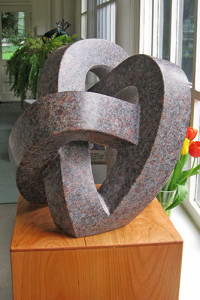The Intimate Gift of Art
Mar 22 2016
By John Bloom and Enrique Perez
“I will say that each sculpture never feels done. You can always keep going on these pieces and keep getting everything more perfect. A lot of the job is to know when to stop and feel that it’s in its moment.” —Miles Chapin, Artist
Completion presents a moment in which the entirely private toil of creativity becomes an opportunity for public experience. For those of us viewing, we know that the artist has invested time and gifts we call talent, or creative capacity, to the production of the work. This is perhaps the most self-evident aspect. After that, we could judge the work simply on the level of craft, but that would entirely miss the deeper purpose—a quality of experiential transmission.
The artist transforms elemental material through the application of imagination, inspiration and intuition. The moment the artist refers to is when the work itself becomes a gift to the world, and illuminates the intimate nature of the gift itself—spirit embedded within transformed matter.
Something rich happens when the artist recognizes that their work is in its moment. The artist’s intentions, manifested through the work, begin to stimulate a sense of meaning in and for viewers. Such a moment is a vulnerable one for the artist.
Relinquishing Control
No artist can presume a knowledge of how people will experience her or his work in a public context. Herein lies the essence of the artistic gift. Within that moment of vulnerability, when the work enters the public view, the artist relinquishes control of the experience, of the work. It is this release of control that defines the nature of gift. The artist’s intentions and being move into the work through the creative process, and are solidified in physical form. They are latent within the work, and accessible to the viewer through a contemplative process, which may or may not connect the viewer with the originating intentions.
This is what we call the intimate nature of gift. If a viewer connects with the work, recognizes its nature, and is awakened or transformed by it, the experience becomes a part of that individual. This process transmits the true gift from the artist’s inception to a public reception.
Axiom Is Born
Sculpture has a special quality in that it offers more than the individual inner experience described above. It also enhances our experience of dynamic space, our movement in relation to it and to each other. We asked sculptor Miles Chapin about this idea and how it relates to the work he recently created for RSF. He responded, “Sculpture itself is about interconnection.”
On November 3, Chapin presented his sculpture—named Axiom—to RSF. He structured it with three interconnected, irregular arches and an open space in the center—an artistic direction inspired by the irregularities Chapin witnesses in nature, and also by Rudolf Steiner’s ideas of the threefold social organism. Formed from a 500-pound mass of Dakota mahogany granite, the piece had a harmonious and process-driven creation. Chapin does not just come up with a concept; he works with the ebbs and flows already existing in the stone.
Chapin grew up on the coast of rural Maine where his retired grandmother would spend time finding interesting rocks and wood on the beach. Chapin joined her in these excursions and adopted the same keen curiosity for the shapes and colors of stones. “Stone has such a sense of place, especially where I grew up,” explains Chapin.
To create the piece, Chapin used various hand tools. But since granite is such a hard material, he also utilized a diamond blade on an angle grinder to cut into the stone. As the extraneous pieces broke off, Chapin proceeded to cut, grind, smooth and polish the stone into its present glossy and textured form. The final piece, now residing in the reception area of RSF’s offices, sits on a cherrywood pedestal that Chapin made specifically for the sculpture.
Asked how he knows when his sculptures are complete, Chapin responds that he is “in search of a feeling for each piece.” Once he achieves that, he says, he no longer worries about anything else. There are those who appreciate his artwork and those that do not understand. Regardless, Chapin embraces the idea of sharing a piece of himself and his voice. And because he does, we at RSF—and all those who visit our offices—have the honor of experiencing the intimate nature of his gift.
John Bloom is Vice President of Organizational Culture at RSF Social Finance.
Enrique Perez is a Marketing Manager at RSF Social Finance.

